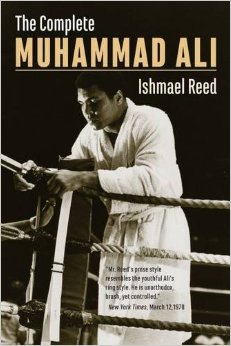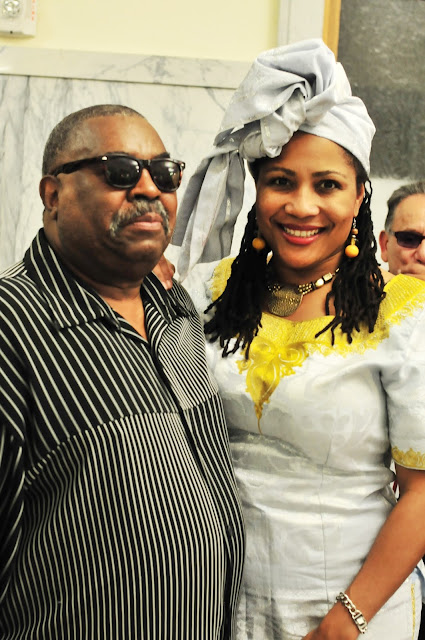Marvin X National Tour 2016
East Coast/West Coast/Dirty South
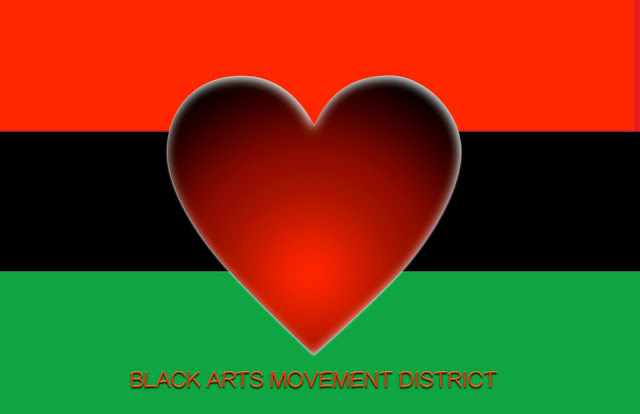
He has two forthcoming books: Sweet Tea/Dirty Rice, New and Selected Poems, 2016, and Notes of an Artistic Freedom Fighter: Essays, Letters, 2016, Black Bird Press, Berkeley CA.

 f
f

Marvin X appeared in Stanley Nelson's film
TENTATIVE TOUR SCHEDULE

Marvin X and Oakland City Council President, Lynette McElhaney
Oakland City Hall Black History Celebration
photo Adam Turner


Marvin
X is the author of 30 books, including poetry, essays, autobiography,
memoir. He has taught at Fresno State University, University of
California, Berkeley and San Diego, San Francisco State University,
Mills College, University of Nevada, Reno, Laney College, Merritt
College. He received writing fellowships from Columbia University (via
Harlem Cultural Council) and the National Endowment for the Arts;
planning grants from the National Endowment for the Humanities, via the
Nevada Cultural Council. His archives were acquired by the Bancroft
Library, University of California, Berkeley. Most recently, Marvin
helped the City of Oakland create the Black Arts Movement Business
District along the 14th Street corridor, downtown.

He has two forthcoming books: Sweet Tea/Dirty Rice, New and Selected Poems, 2016, and Notes of an Artistic Freedom Fighter: Essays, Letters, 2016, Black Bird Press, Berkeley CA.

His writings appear in Ishmael Reed's The Complete Muhammad Ali
His poetry appears in Black Gold Poetry Anthology
This is his 13 Step manual to recover from the addiction to white supremacy
foreword by Dr. Nathan Hare
foreword by Dr. Nathan Hare
Writers at memorial for Jayne Cortez and Amiri Baraka, New York University
Marvin X Fan Club
The Black Arts Movement Poets Choir and Arkestra, University of California, Merced, 2014
Marvin X participated in the Sun Ra Conference, University of Chicago, 2015
Marvin X and Sun Ra worked together in Harlem, 1968, at UC Berkeley, 1971-72. During this time, Sun Ra arranged the musical version of Flowers for the Trashman, retitled Take Care of Business, produced at Marvin's Black Educational Theatre, San Francisco, 1972
Marvin and Oakland CA Mayor Libby Schaaf, a supporter of the Black Arts Movement
Marvin X in conversation with Amiri Baraka, Lannan Foundation, Santa Fe, New Mexico
His writings appear in the BAM Reader, also in the BAM Classic Black Fire
 f
f
Marvin X appeared in Stanley Nelson's film
Director Stanley Nelson, Marvin X, Fred Hampton, Jr.
"Marvelous Marvin X!"--Dr. Cornel West
Marvin X and daughter Nefertiti at Laney College BAM 50th Celebration. In this inter-generational
panel discussion, she urged her father to pass the baton!
.jpg) Panel Discussion: Women and the Black Arts Movement, Laney College BAM
50th Celebration, 2014. Left to Right: Elaine Brown, Dr. Halifu Osumare,
Judy Juanita, Portia Anderson, Kujichagulia, Aries Jordan. Marvin X,
producer.
Panel Discussion: Women and the Black Arts Movement, Laney College BAM
50th Celebration, 2014. Left to Right: Elaine Brown, Dr. Halifu Osumare,
Judy Juanita, Portia Anderson, Kujichagulia, Aries Jordan. Marvin X,
producer.
.jpg) Panel Discussion: Women and the Black Arts Movement, Laney College BAM
50th Celebration, 2014. Left to Right: Elaine Brown, Dr. Halifu Osumare,
Judy Juanita, Portia Anderson, Kujichagulia, Aries Jordan. Marvin X,
producer.
Panel Discussion: Women and the Black Arts Movement, Laney College BAM
50th Celebration, 2014. Left to Right: Elaine Brown, Dr. Halifu Osumare,
Judy Juanita, Portia Anderson, Kujichagulia, Aries Jordan. Marvin X,
producer.TENTATIVE TOUR SCHEDULE
February 24, Black History, Oakland City Hall
Oakland City Hall Black History Celebration
photo Adam Turner
April 23, Memorial for Hugo "Yogi" Panell, San Quentin Six member,
African American Cultural Center, San Francisco. Marvin X spoke and
read.


Hugo "Yogi" Panell, San Quentin Six
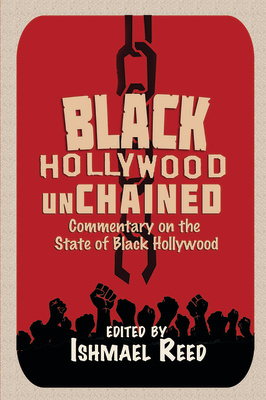
May 15, 2016 New York City reading of contributors to anthology, Black Hollywood unchained, edited by Ishmael Reed, Third World Press, Chicago.
A
scene from Marvin X's BAM classic Flowers for the Trashman, produced by
Kim McMillon's theatre students at University of California, Merced.
Students and Marvin X in Kim McMillon's class on theatre and social
activism. "My students love Marvin X!" says Professor McMillon.
May
25, University of California, Merced, Marvin X speaks in Professor Kim
McMillon's theatre class on his role in the Black Arts Movement as
artistic freedom fighter and playwright, author of the BAM classic
Flowers for the Trashman.
May
29, Marvin X celebrates his 72nd birthday. Travels to outter space.
June 18, San Francisco Juneteenth, in the Fillmore. Marvin X and Fillmore Slim will perform "What is Love?" a poem by Marvin. At rehearsal, Fillmore answered, "Love is the Blues!" He will accompany Marvin on acoustic guitar.
Marvin X and Fillmore Slim
June 19, Berkeley Juneteenth, Marvin X autographs books, exhibits archives of the Black Arts Movement.
June 25, (West Oakland Juneteenth)
July 3, San Francisco Public Library, reading of Black Hollywood unChained contributors

July 23, Oakland Black Expo, Frank Ogawa/Oscar Grant Plaza

September, 9-11 Black Arts Movement South 51st Anniversary Celebration, Dillard University, New Orleans, LA

Marvin X in previous appearance at University of Houston TX
September, University of Houston, Texas, Africana Studies, Texas Southern University and elsewhere in the Big H. TBA
September, Black Arts Movement Theatre Festival, Flight Deck Theatre, Oakland
TBA
The Black Arts Movement Business District
presents
BAM THEATRE FESTIVAL
September 2016
The plays


The Toilet by Amiri Baraka
Flowers for the Trashman by Marvin X
A scene from Marvin X's BAM classic Flowers for the Trashman, produced by Kim McMillon's theatre students at University of California, Merced.
Bathroom Graffiti Queen
by Opal Palmer Adisa
produced by
Dr. Ayodele Nzinga
The Lower Bottom Playaz
September, Black Book Store, Seattle Wa, hosted by Hakim, TBA
August 1, September 30, Laney College Theatre, Oakland, Marvin X opens
for Donald Lacy's Color Struck.
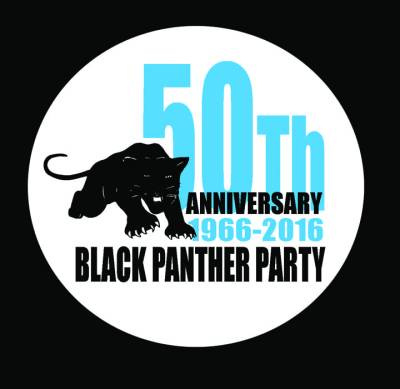
October, 20-23 Black Panther Party 50th Anniversary at Oakland Museum of California. Marvin X speaks/reads.
* * * *
*

Marvin X, poet, playwright, essayist, producer, director, actor, organizer, educator
photo Pendarvis Harshaw









Invite Marvin X!
He's living Black History!
He’s the new Malcolm X! Nobody’s going to talk about his book, HOW TO RECOVER FROM THE ADDICTION TO WHITE SUPREMACY, out loud, but they’ll hush hush about it.—Jerri Lange, author, Jerri, A Black Woman’s Life in the Media

To book Marvin X: jmarvinx@yahoo.com
510-200-4164
Invite Marvin X for Black History Month or Anytime. He's living Black History!









He's living Black History!
He’s the new Malcolm X! Nobody’s going to talk about his book, HOW TO RECOVER FROM THE ADDICTION TO WHITE SUPREMACY, out loud, but they’ll hush hush about it.—Jerri Lange, author, Jerri, A Black Woman’s Life in the Media

He
is a Master Teacher in many fields of thought—religion and psychology,
sociology and anthropology, history and politics, literature and the
humanities. He is a needed Counselor, for he knows himself, on the
deepest of personal levels and he reveals that self to us, that we might
be his beneficiaries…. If you want to reshape (clean up, raise) your
consciousness, this is a book to savor, to read again and again—to pass
onto a friend or lover.
—Rudolph Lewis, Editor, ChickenBones: A Journal
….Malcolm X ain’t got nothing on Marvin X. Still Marvin has been ignored and silenced like Malcolm would be ignored and silenced if he had lived on into the Now. Marvin’s one of the most extraordinary, exciting black intellectuals living today—writing, publishing, performing with Sun Ra’s Musicians (Live in Philly at Warm Daddies, available on DVD from BPP), reciting, filming, producing conferences (Kings and Queens of Black Consciousness, 2001,San Francisco Black Radical Book Fair, 2004); he’s ever engaging, challenging the respectable and the comfortable. He like Malcolm, dares to say things fearlessly, in the open (in earshot of the white man) that so many Negroes feel, think and speak on the corner, in the barbershops and urban streets of black America….
—Rudolph Lewis, Editor, ChickenBones: A Journal

…People who know Marvin X already know him as a peripatetic, outspoken, irreverent, poetic “crazy nigger,” whose pen is continually and forever out-of-control. As a professional psychologist, I hasten to invoke the disclaimer that that is in no way a diagnosis or clinical impression of mine. I have never actually subjected this brother to serious psychoanalytical scrutiny and have no wish to place him on the couch, if only because I know of no existing psycho-diagnostic instrumentality of pathology of normalcy that could properly evaluate Marvin completely.
—Dr. Nathan Hare, Black Think Tank, San Francisco
Marvin X has been a witness to history. He shows that an excellent minority writer can raise issues that the mainstream publishers and book reviewers find hard to grapple with…. He, Huey P. Newton, Eldridge Cleaver and others were also casualties of the chemical attack on African Americans in the form of Crack and alcohol waged by corporations and a government that placed questionable foreign policy goals above the health of its citizens…. Many of those who inspired the cultural revolution of the 1960s remain stuck there. This volume shows that Marvin X has moved on.
—Ishmael Reed, novelist, poet, essayist, publisher, Oakland

Iraq…how did we get there and how do we get back? The consciousness-altering book of poems that tells the tale, in no uncertain terms and yet always via poetry, is the astonishing Land of My Daughters: Poems 1995-2005 by Marvin X. Marvin X is the USA’s Rumi, and his nation is not “where our fathers died” but where our daughters live. The death of patriarchal war culture is his everyday reality. X’s poems vibrate, whip, love in the most meta- and physical ways imaginable and un-. He’s got the humor of Pietri, the politics of Baraka, and the spiritual Muslim grounding that is totally new in English—the ecstasy of Hafiz, the wisdom of Saadi. It’s not unusual for him to have a sequence of shortish lines followed by a culminating line that stretches a quarter page—it is the dance of the dervishes, the rhythms of a Qasida.
—Bob Holman, Bowery Poetry Club, New York City
—Rudolph Lewis, Editor, ChickenBones: A Journal
….Malcolm X ain’t got nothing on Marvin X. Still Marvin has been ignored and silenced like Malcolm would be ignored and silenced if he had lived on into the Now. Marvin’s one of the most extraordinary, exciting black intellectuals living today—writing, publishing, performing with Sun Ra’s Musicians (Live in Philly at Warm Daddies, available on DVD from BPP), reciting, filming, producing conferences (Kings and Queens of Black Consciousness, 2001,San Francisco Black Radical Book Fair, 2004); he’s ever engaging, challenging the respectable and the comfortable. He like Malcolm, dares to say things fearlessly, in the open (in earshot of the white man) that so many Negroes feel, think and speak on the corner, in the barbershops and urban streets of black America….
—Rudolph Lewis, Editor, ChickenBones: A Journal


…People who know Marvin X already know him as a peripatetic, outspoken, irreverent, poetic “crazy nigger,” whose pen is continually and forever out-of-control. As a professional psychologist, I hasten to invoke the disclaimer that that is in no way a diagnosis or clinical impression of mine. I have never actually subjected this brother to serious psychoanalytical scrutiny and have no wish to place him on the couch, if only because I know of no existing psycho-diagnostic instrumentality of pathology of normalcy that could properly evaluate Marvin completely.
—Dr. Nathan Hare, Black Think Tank, San Francisco
Marvin X has been a witness to history. He shows that an excellent minority writer can raise issues that the mainstream publishers and book reviewers find hard to grapple with…. He, Huey P. Newton, Eldridge Cleaver and others were also casualties of the chemical attack on African Americans in the form of Crack and alcohol waged by corporations and a government that placed questionable foreign policy goals above the health of its citizens…. Many of those who inspired the cultural revolution of the 1960s remain stuck there. This volume shows that Marvin X has moved on.
—Ishmael Reed, novelist, poet, essayist, publisher, Oakland

Iraq…how did we get there and how do we get back? The consciousness-altering book of poems that tells the tale, in no uncertain terms and yet always via poetry, is the astonishing Land of My Daughters: Poems 1995-2005 by Marvin X. Marvin X is the USA’s Rumi, and his nation is not “where our fathers died” but where our daughters live. The death of patriarchal war culture is his everyday reality. X’s poems vibrate, whip, love in the most meta- and physical ways imaginable and un-. He’s got the humor of Pietri, the politics of Baraka, and the spiritual Muslim grounding that is totally new in English—the ecstasy of Hafiz, the wisdom of Saadi. It’s not unusual for him to have a sequence of shortish lines followed by a culminating line that stretches a quarter page—it is the dance of the dervishes, the rhythms of a Qasida.
—Bob Holman, Bowery Poetry Club, New York City
To book Marvin X: jmarvinx@yahoo.com
510-200-4164


